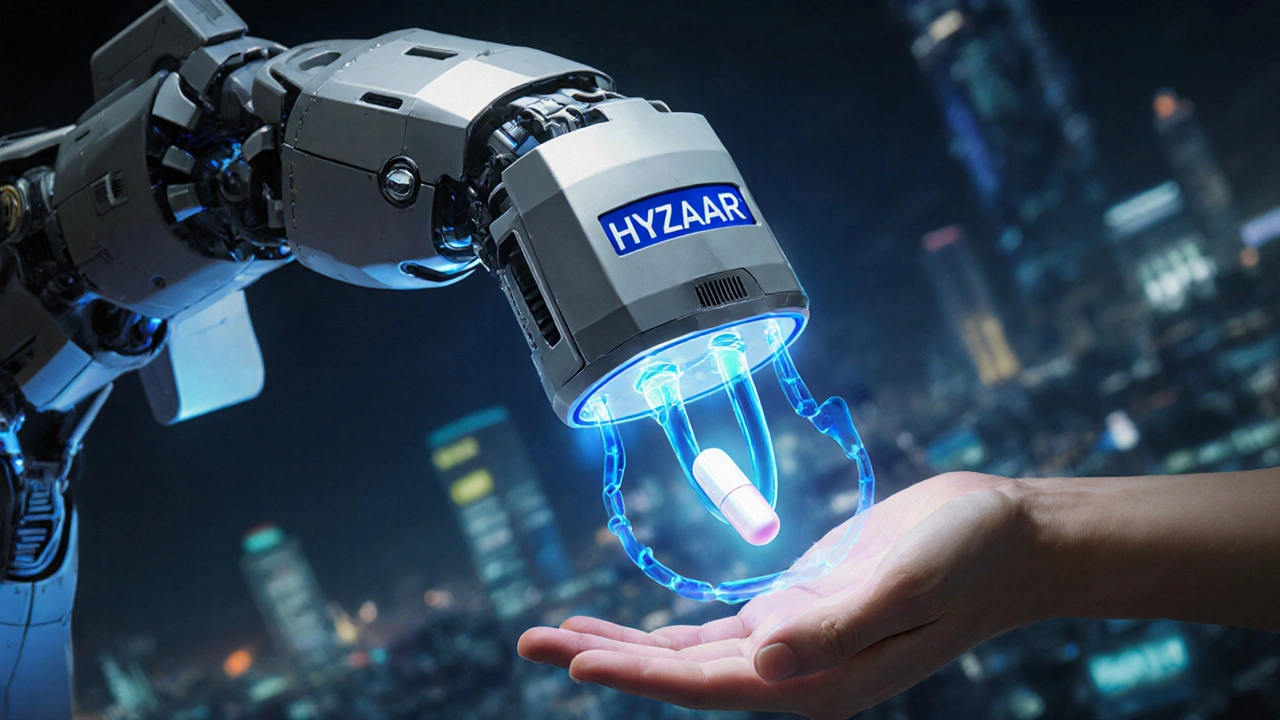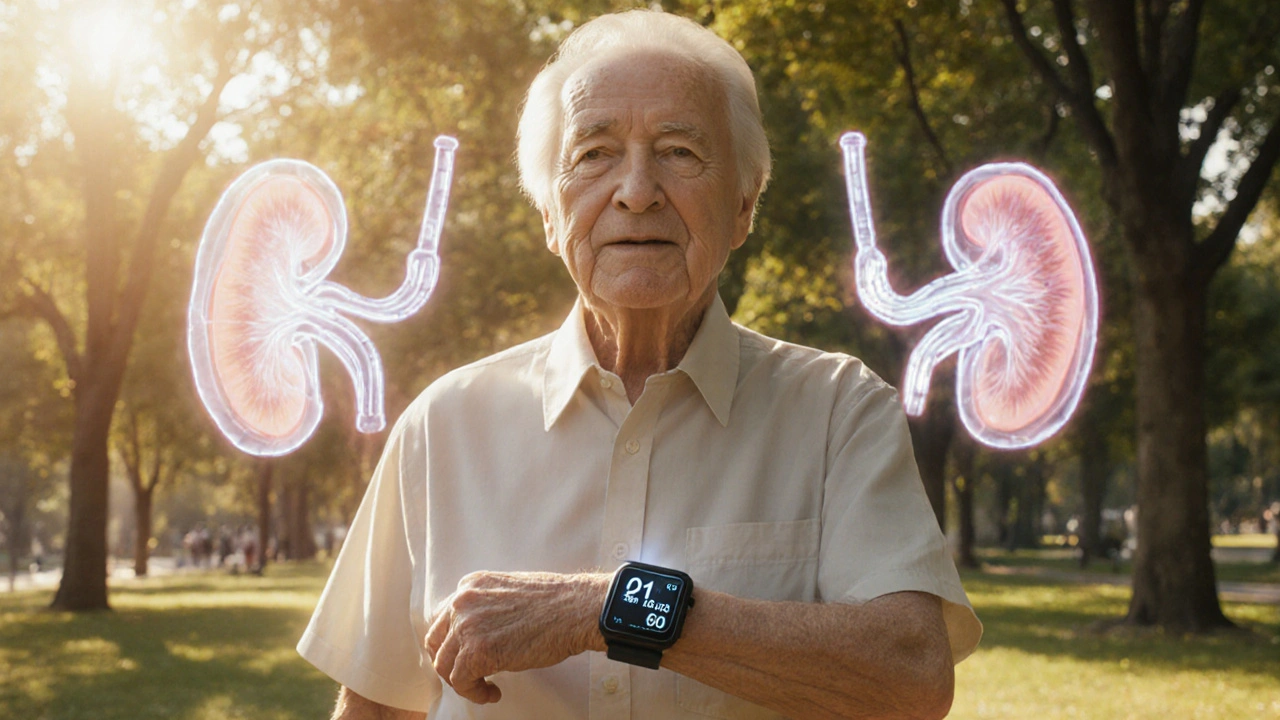 Jun, 17 2025
Jun, 17 2025
Hyzaar isn’t just another pill in the medicine cabinet. It’s a combination drug used by millions to control high blood pressure - and if you’ve been prescribed it, you probably want to know exactly what you’re taking, why it works, and what to watch out for. This isn’t a drug you take lightly. It’s powerful. It’s effective. And if used wrong, it can cause real problems.
What is Hyzaar, really?
Hyzaar is a single pill that contains two active ingredients: losartan and hydrochlorothiazide. Losartan belongs to a class of drugs called angiotensin II receptor blockers (ARBs). Hydrochlorothiazide is a diuretic, often called a water pill. Together, they work in two different ways to lower blood pressure - and that’s why doctors often choose this combo over single drugs.
Losartan relaxes your blood vessels by blocking a chemical in your body that normally makes them tighten. Hydrochlorothiazide helps your kidneys get rid of extra salt and water, which reduces the volume of blood flowing through your vessels. Less pressure. Lower numbers. That’s the goal.
Hyzaar comes in three strengths: 50 mg/12.5 mg, 100 mg/12.5 mg, and 100 mg/25 mg. The numbers refer to the amount of losartan and hydrochlorothiazide in each tablet. Your doctor picks the dose based on your blood pressure levels, how you respond to treatment, and whether you’ve taken either drug before.
Who gets prescribed Hyzaar?
Hyzaar is approved for adults with hypertension - that’s the medical term for high blood pressure. It’s not for kids. It’s not for temporary spikes in blood pressure. It’s for people whose blood pressure stays too high over time, putting strain on their heart, kidneys, and blood vessels.
Doctors often prescribe Hyzaar when one drug isn’t enough. Maybe you took losartan alone and your systolic number (the top number) still hovered around 150. Or maybe you tried hydrochlorothiazide and felt dizzy from low potassium. Combining them can give better control with fewer side effects than increasing doses of a single drug.
It’s also used in patients with type 2 diabetes and proteinuria (protein in the urine). Losartan has been shown in clinical trials to slow kidney damage in these patients - something not all blood pressure drugs can do.
How does Hyzaar actually lower blood pressure?
Let’s break it down simply.
First, losartan blocks angiotensin II, a hormone that narrows blood vessels and tells your body to hold onto sodium and water. When you block it, your vessels relax. Blood flows easier. Pressure drops.
Second, hydrochlorothiazide makes you pee out more sodium and water. Less fluid in your bloodstream means less pressure on your artery walls. It’s like draining a water balloon - it shrinks, and the walls don’t stretch as tight.
Together, they hit blood pressure from two angles. That’s why studies show Hyzaar works better than either drug alone. In one trial involving over 1,200 patients, 68% of those on Hyzaar 100/25 reached their target blood pressure (below 140/90), compared to just 49% on losartan alone.
It usually takes about 2 to 4 weeks to see the full effect. Don’t expect miracles after one dose. Consistency matters more than timing.
What are the side effects?
Most people tolerate Hyzaar well. But side effects happen - and you need to know which ones are normal and which need a doctor’s attention.
Common side effects (affecting up to 1 in 10 people):
- Dizziness, especially when standing up quickly
- Low blood pressure (you might feel lightheaded or faint)
- Upset stomach or diarrhea
- Back pain
- Cough (less common than with ACE inhibitors, but still possible)
Less common but serious side effects:
- High potassium levels (hyperkalemia) - can cause irregular heartbeat
- Low sodium or low magnesium - leads to muscle cramps, weakness, or confusion
- Severe allergic reaction - swelling of the face, lips, throat, or tongue
- Reduced kidney function - especially if you’re dehydrated or have existing kidney disease
- Increased sensitivity to sunlight - can cause bad sunburns
If you feel your heart racing, get dizzy often, or notice swelling in your ankles or face, call your doctor. Don’t wait.

What should you avoid while taking Hyzaar?
Some things can make Hyzaar dangerous or less effective.
Don’t take potassium supplements. Hydrochlorothiazide lowers potassium, but losartan can raise it. Taking extra potassium pills can push your levels into a dangerous range. Same goes for salt substitutes - many contain potassium chloride.
Avoid NSAIDs like ibuprofen or naproxen. These can reduce the effectiveness of Hyzaar and increase the risk of kidney damage, especially if you’re older or already have kidney issues.
Stay hydrated. Diuretics make you lose fluid. If you’re sweating a lot, vomiting, or have diarrhea, you can get dehydrated fast. That can cause your blood pressure to drop too low or harm your kidneys.
Don’t drink alcohol heavily. Alcohol lowers blood pressure too. Combine it with Hyzaar, and you could pass out or fall.
Check your skin. Hydrochlorothiazide increases sun sensitivity. Wear sunscreen, a hat, and long sleeves when outdoors. A bad sunburn isn’t just painful - it can be a sign of something more serious.
Who shouldn’t take Hyzaar?
Hyzaar isn’t safe for everyone.
- If you’re allergic to sulfa drugs, avoid it - hydrochlorothiazide is a sulfa-based diuretic.
- If you’re unable to make urine (anuria), don’t take it.
- If you’re pregnant, especially in the second or third trimester, Hyzaar can cause serious harm or death to the unborn baby. Stop taking it immediately if you become pregnant.
- If you have severe liver disease, your doctor may need to adjust your dose or avoid it altogether.
- If you’re on lithium, Hyzaar can increase lithium levels to toxic amounts.
Always tell your doctor about all your medical conditions - including gout, diabetes, lupus, or asthma - before starting Hyzaar.
How do you take it correctly?
Take Hyzaar exactly as prescribed. Usually once a day, with or without food. Many people take it in the morning to avoid frequent nighttime bathroom trips.
Don’t skip doses. If you forget one, take it as soon as you remember - unless it’s close to your next dose. Then skip the missed one. Never double up.
Keep taking it even if you feel fine. High blood pressure has no symptoms. Feeling good doesn’t mean your pressure is under control. That’s why regular check-ups and home monitoring matter.
Use a pill organizer. Many people on Hyzaar take other meds for cholesterol, diabetes, or heart rhythm. Keeping track is easier with a simple box.

What are the alternatives?
If Hyzaar doesn’t work for you - or if side effects are too much - there are other options.
- Other ARB + diuretic combos: Benicar HCT (olmesartan + hydrochlorothiazide), Atacand HCT (candesartan + hydrochlorothiazide)
- ACE inhibitor + diuretic: Prinivil HCT (lisinopril + hydrochlorothiazide) - but ACE inhibitors cause cough more often than ARBs
- Calcium channel blocker + diuretic: Norvasc HCT (amlodipine + hydrochlorothiazide)
- Single-pill ARB: Losartan alone, if your blood pressure is only mildly high
- Non-pill options: Lifestyle changes - weight loss, low-sodium diet, walking 30 minutes daily - can lower blood pressure as much as some meds.
There’s no single best drug. It depends on your age, race, other conditions, and how your body responds. Your doctor will test and tweak until they find the right fit.
How much does Hyzaar cost?
Brand-name Hyzaar can cost $150 to $200 a month without insurance. But most people pay far less.
The generic version - losartan/hydrochlorothiazide - is widely available and costs as little as $10 to $20 a month at major pharmacies like Walmart, Costco, or CVS. Many insurance plans cover it at Tier 1 (lowest copay).
If you’re struggling to pay, ask your doctor about patient assistance programs. The manufacturer, Sanofi, has one. So do nonprofit organizations like NeedyMeds and RxAssist.
What’s the long-term outlook?
Hyzaar isn’t a cure. It’s a tool. Used right, it can prevent strokes, heart attacks, and kidney failure. People who stick with their blood pressure meds reduce their risk of stroke by up to 40% and heart disease by 25%.
But it only works if you take it. Miss doses, and your pressure creeps back up. You might not feel it - but your arteries are still under stress.
Pair Hyzaar with healthy habits: cut back on salt, eat more vegetables, move daily, limit alcohol, and manage stress. These aren’t extras - they’re part of the treatment.
Regular check-ups are non-negotiable. Your doctor will monitor your kidney function, electrolytes, and blood pressure. That’s how they know if the dose needs adjusting or if something else is going on.
Hyzaar saved lives. But only if it’s used the right way.
Can Hyzaar cause weight gain?
No, Hyzaar doesn’t cause weight gain. In fact, it often leads to a small amount of weight loss because it removes excess fluid from your body. But if you notice sudden weight gain - more than 5 pounds in a few days - it could mean your kidneys aren’t working well or you’re retaining fluid. Contact your doctor.
Is Hyzaar safe for older adults?
Yes, but with caution. Older adults are more sensitive to blood pressure drops and dehydration. Doctors usually start with a lower dose (like 50/12.5 mg) and monitor kidney function and potassium levels more closely. Falls from dizziness are a real risk, so balance and hydration matter.
Can I take Hyzaar with grapefruit juice?
Yes, unlike some blood pressure drugs, Hyzaar doesn’t interact with grapefruit juice. Losartan and hydrochlorothiazide aren’t broken down by the same liver enzymes that grapefruit affects. You can safely enjoy your morning glass.
Does Hyzaar affect your sex drive?
It’s rare, but possible. Some men report decreased libido or erectile dysfunction, though this is more common with older diuretics. Losartan is less likely to cause this than beta-blockers or older diuretics. If it happens, talk to your doctor - switching to another ARB combo might help.
How long do I need to take Hyzaar?
For most people, high blood pressure is a lifelong condition. You’ll likely need to take Hyzaar - or another medication - indefinitely. Stopping it suddenly can cause your blood pressure to rebound dangerously high. Never quit without talking to your doctor first.